ISSN ONLINE(2278-8875) PRINT (2320-3765)
ISSN ONLINE(2278-8875) PRINT (2320-3765)
S.M. Shashidhara1 and Dr.P. Sangameswara Raju2
|
| Related article at Pubmed, Scholar Google |
Visit for more related articles at International Journal of Advanced Research in Electrical, Electronics and Instrumentation Engineering
With the proliferation of advanced technologies in signal processing, spectrum estimation of AC machines has lead to the accurate and precise identification of different faults. The popular machine in most of the industrial applications is a squirrel cage induction motor and failures of such significant motors may have severe consequences such as product quality, ageing, safety, and costs. Most of the condition monitoring techniques in induction motors generally involve with single and specific fault identification. This paper proposes a novel investigation technique for optimized identification of two or more combined faults of an induction motor. The contribution of this paper is a methodology that suits for hardware development, which integrates induction motor data with cRIO system to identify the faults such as broken rotor bars, vibration effects (eccentricities), leakage flux condition and stator current status. To ensure the performance response of proposed methodology, tests are conducted on a 2 kW induction motor in a laboratory, which show highly satisfactory results that prove its suitability for on-line detection of single and multiple combined faults in a flexible way through its hardware implementation in a field programmable gate array (FPGA) environment.
Keywords |
| Induction Motor, Multiple Faults, Fault Diagnosis, Detection, FPGA. |
INTRODUCTION |
| Eleactromechanical energy conversion systems (motors and generators) are effectively employed for various industrial applications including renewable energy conversions, electric drive systems, mining, aircraft, and petroleum products, etc. The induction motors dominate other electro-mechanical rotating machines with respect to rotor inertia, maximum efficiency,highest speed capability, size, volume and cost [1]. Hence, the assessment of running conditions and reliability of induction machines are critical to avoid random and catastrophic failures in most of the applications. Consequently, the issue of continuous monitoring and non-invasive diagnosis of these induction machines is of high concern, and is becoming increasingly significant [2]. |
| In the last two decades, a large amount of research work has been reported on using the stator current spectrum to sense the rotor faults associated with mechanical unbalance and rotor broken bars [3-8]. These techniques require highly skilled operator/user in order to distinguish a normal operating condition from a potential failure state. This is so, as the monitored spectral components (either current or vibration) are based on number of factors, including normal operating conditions [9]. |
| In [10], power supply and motor faults are detected from electrical parameter measurements through a membership functions method based on a pattern recognition solution has been reported. The wavelet transform techniques are other known techniques which have proven their efficacy on induction motor fault detection, reported in [11-13]. These techniques are associated with time-frequency information from non-stationary signals. Artificial intelligence techniques have also found significant role in fault detection and diagnosis of induction motors. For instance, neural networks and Weibull hazard rates techniques [14] are employed for the determination of remaining active life bearings. In [15], the authors have described about the severity of the broken rotor bars and load level of the system identification by fuzzy logic and generic algorithms. In [16] and [17], the authors have made effort in employing information entropy technique for the detection of rotor broken bars. Unfortunately, this technique is limited to single isolated fault identification because of its inherent statistical nature [17]. |
| Now a day, the employment of cRIOTM offers an attractive technique, wh i c h exhibits flexible and improved performance along with its compact size [18]. This technique has been employed for various applications such as medical equipment monitoring, automatic control in magnetic system and engine control in motor cycle vehicles. Hence, the research effort has been made in the effective utilization of Laboratory Virtual Instrument Engineering Workbench (LabVIEW) cRIO with Field Programmable Gate Array (FPGA) environment for the continuous monitoring of induction motor. The flexibility of proposed technique is that, it accepts multiple sensor signals and capable of accommodating custom signal analysis tools. Moreover, this system provides a real-time and continuous monitoring platform. In addition, this proposed system has a special feature of visual inspection opportunity for staff about in condition monitoring. |
FAULT FREQUENCIES IN INDUCTION MOTORS |
| It is well known that, a current spectrum of a faulty system is composed of potential fault information. However, the frequency components of each fault can be determined through various techniques. It is also important to know that, just as in vibration analysis, as the fault progresses, its characteristic spectral components continue to increase over a time. |
A. Bearing faults: |
| The bearing fault current harmonics can be described [1], [2], and [18], by following equations, |
| Where fs is supply frequency of the system. fo and fi are related to outer and inner race, respectively, and Nb is the number of balls, and f0 and fi are given by, |
 |
| Where, ‘BD’ and ‘PD’ are, respectively, the ball diameter and the pitch diameter, and β is the contact angle between the balls and the ball bearing rings. |
B. Rotor faults: |
| End rings and broken bars of the rotor induce the same harmonics in the stator currents. Hence, the amplitude of stator current will be modulated by the slip frequency factor, which is given by 2.s.fs. Here “s” is per unit slip. This increase in the modulation is based on the severity of the fault. In the current spectrum, the harmonics [18-21] due to the rotor fault can be found from the following characteristic equation: |
| Where ‘n’ is an integer. |
C. Stator Faults: |
| The stator current related faults can be identified by using the fault frequency measurement, which can be observed by the FFT analysis of the voltage, current and axial flux signals [18-23]. |
 |
| Where, ‘p’ is the number of pole pairs of the induction motor and ‘k’ is an integer. It has been reported that, 2.fs or a combination of rotor frequency (fr), 2.fr, and 2.fs can be an indication of stator faults in vibration based monitoring. |
D. Eccentricity Faults: |
| In the literature, other possible mechanical imbalance faults of induction motor have been reported in [1], [18], [19], and [20]. Eccentricity is also one of the major kinds of induction motor faults in which the frequency analysis is made based on following expression: |
 |
| Where, |
| fec = eccentricity frequency, fs= supply frequency, r = number of slots |
| p = pole pairs, n = 1, 3, 5… |
REAL-TIME EMBEDDED SYSTEM DEVELOPMENT |
| This is the heart of the system which essentially reduces the complexity, running time as well as, it provides tools for monitoring and identification of faults in the system. cRIO technology combines flexibility and the processing power of a field-programmable gate array (FPGA) with greater reliability of a real-time processor. cRIO consists of three constituents (Fig. 1): |
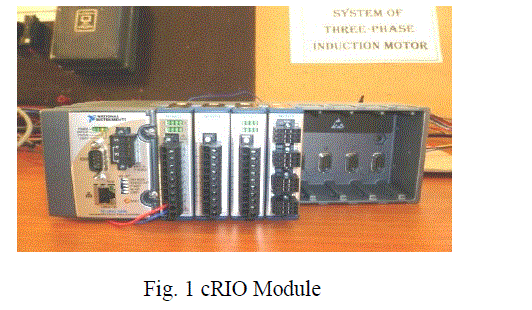 |
| A processor to execute LabVIEW applications for reliable real-time operating system (RTOS); reconfigurable embedded chassis with FPGA core that can be accessed and onfigurable using LabVIEW graphical development environment; hot-swappable industrial grade I/O modules with built-in signal conditioning which can be directly connected to a wide range of range of sensors and actuators. |
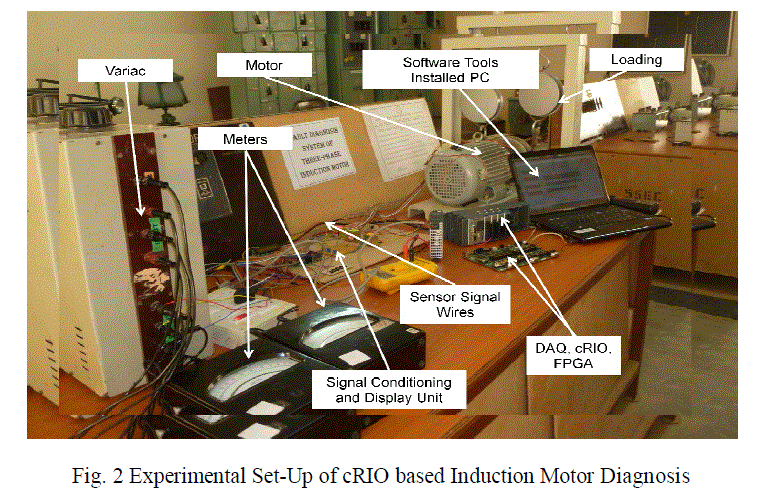 |
| Fig. 2 shows the experimental Set-Up of cRIO based Induction Motor Diagnosis system. In this system, cRIO performs averaging, fast Fourier transform (FFT) analysis, windowing, peak and fault detection analysis. In this, the data transfer has been executed effectively through the network port. However, read/write instruction, execution time critical loop tasks, reading data from machine status has been carried out by FPGA Chassis. The AI module is employed for capturing vibrations, current, voltage and flux signals using suitable signal conditioning devices and sensors. A custom-design display module is designed to provide an on-line fault diagnosis and display/alarm to the operator/user. It mainly deals with various groups of motor faults and its associated threshold levels. It also indicates the fault status and condition of the machine. |
RESOURCES |
| The cRIO platform features a small, rugged, scalable, modular, embedded architecture comprising of an FPGA, an RT processor and isolated I/O devices [21]. cRIO has industrial class certification for high temperatures, hazardous locations or potentially explosive environments and shock capability. It is a good candidate to be used in an industrial environment. |
| The CRIO architecture has similarity to that of the desktop systems but with FPGA plug-in boards. The floating-point processor that can be programmed with LabVIEW Real-Time is connected to the FPGA on the backplane through an internal PCI bus. The cRIO modules consist of conversion circuitry (for analog modules), electrical isolation, signal conditioning, permitting direct connection to sensors on the motor. |
| Real-time system development is a multistep process that includes (i) programming, (ii) debugging, (iii) compiling, (iv) downloading and (v) deploying. LabVIEW Real-Time is a unique facility, as it creates advanced realtime applications but takes advantage of all the benefits of LabVIEW for Windows graphical programming environment. While developing real-time software, performance must be ascertained at each step of process. The execution speed of each component requires to be measured to ensure that they match their expected performance criteria. During system integration, the performance of the system needs to be continually checked for the same reason. |
| All the input channels fulfill the necessity of sensor signals that were applied in the condition monitoring system. This module is suitable for condition monitoring applications because it is equipped with eight analog input channels. The analog channels can capture 10.8V maximum amplitude signals. In addition, this module also contains an analog-todigital converter (ADC), and noise-immunity system, which are preferable features in signal measurements for condition monitoring. This work investigates the detection of multiple faults (i.e. stator shorted turn faults, eccentricity faults, bearing faults and broken rotor bar faults) using three types of sensor signals (i.e. current, vibration and leakage flux) under varied load levels. |
| The uniqueness of this work is the advancement of a highly reliable, low-cost, multichannel multisensory analysis platform, based on the spectrum estimator, capable of providing an automatic diagnosis of the motor state. This system carries out on-line continuous monitoring with the help of a post-processing module that automatically assesses the estimated spectrum, accordingly to the specific failure under diagnosis. All the approaches mentioned before, require the usage of FPGA technology that allows developing low-cost, rapid and reconfigurable architectures for real-time analyses [24]; Hence, the primary contribution of this work is the utilization of an FPGA based cRIO module for developing an on-line multichannel spectrum analysis based continuous monitoring of multiple sensor signals with an embedded postprocessor for an automatic diagnosis of the machine state. |
EXECUTION OF SOFTWARE |
| The cRIO based condition monitoring system is programmed using LabVIEWTM along with necessary constraints based on motor condition. This main VI as shown in block diagram Fig. 3 acquires data continuously from the designated channel and carries out the scaling of the data to appropriate engineering units. Then program performs windowing of the signal, and the averaged frequency measurement. Power Spectrum, Power Spectral Density, and FFT are available frequency measurements. The VI returns the frequency resolution and the period of the acquisition time, based on the scan rate and the number of samples. |
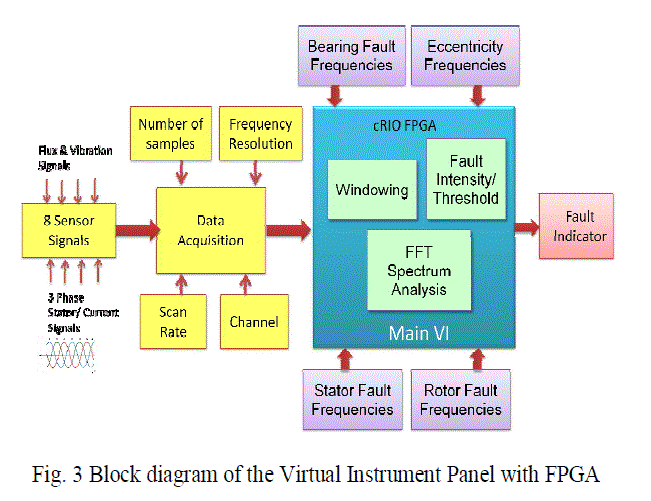 |
| The main Virtual Instrument panel comprises of subVIs for the detection of various faults. SubVIs are custom designed for various faults to be detected by the cRIO real-time monitoring software. The cRIO condition monitoring system is used to detect broken rotor bar, eccentricity, stator shorted turns and bearing faults. |
| Fig. 4 shows flowchart of the developed software for fault identification and detection. As it is depicted in flowchart, FPGA performs multiple operations simultaneously, such as, acquiring the 8-channel data & performing low pass antialiasing filtering, and transferring the data via direct memory access (DMA). It also drives the custom-mode display module via SPI. |
| The Induction machine data analysis is mainly performed in the real-time controller. In this execution, the process sequence is as follows: initialization of data, machine data calibration from relevant sensors, followed by FFT analysis, peak detection of fault frequency and frequency averaging. Once the FFT analysis of induction motor is monitored, a number of subroutines are executed to identify exact faults based on the valid fault frequency equations described in section II. With this, the fault level algorithms are implemented to estimate the specific fault levels based on the peak values of the fault frequencies. |
| The fault detection algorithm uses a threshold value for a particular parameter. There are standard values, which show the allowable levels of vibration magnitudes based on the motor size. There are empirically developed values for various fault frequencies and their magnitudes in the spectrum analysis procedures. For broken rotor bars, in current spectrum, if sidebands are less than -54 dB with respect to the main peak then the motor is considered healthy, if they are larger than -45 dB then the motor would be indicated as faulty, else it comes in marginal band. Threshold values for the peaks of side band frequencies are stored in the program data for comparison and decision-making. |
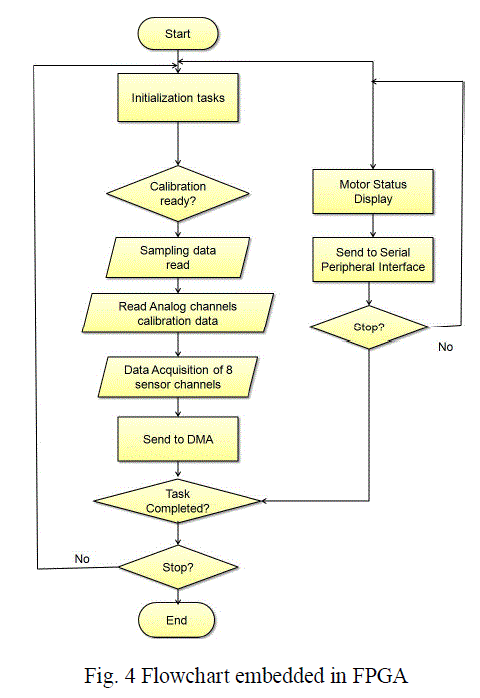 |
RESULTS AND DISCUSSION |
| In this work, to ensure the performance and to analyse the steady-state response of the system, various tests were conducted. The steady-state current, voltage, flux and vibration signals are obtained from the motor and are used to find the multiple mixed faults and their corresponding classification; The specifications of the induction motor under test considered for various faults is Crompton Greaves make, 4-pole, 3 HP, 415 V, 1440 rpm and 4.6A. |
| The implemented on-line condition monitoring system essentially identifies and detects the single and multiple mixed fault conditions dealt in this paper. Using the cRIO embedded system; Induction Motor fault detection system has been prototyped. Fig. 5 presents the threshold limit testing process on front panel of VI. Fault intensity threshold levels are provided in the program. |
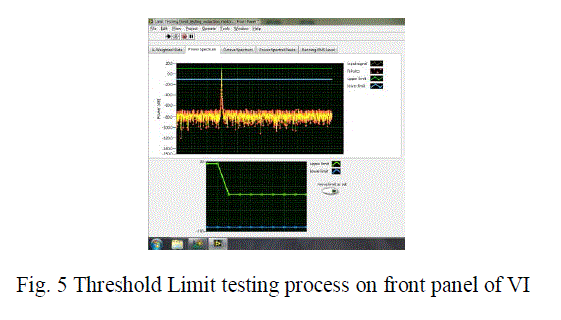 |
| In cRIO system, an execution Fig. 6 shows the summary of the execution time durations of the fault detection and the diagnosis algorithms. |
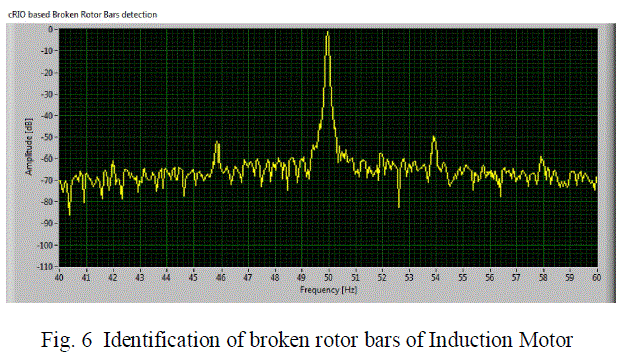 |
| While, the multiple and mixed faults analysis system is in the on-line mode, the time taken for bearing, stator and rotor fault frequency model calculations is 2 ms approximately. Limit testing of bearing, stator, rotor, setup, eccentricities, and supply faults has taken 20 ms. From the literature, it has been noticed that, the execution time duration of the algorithm for the proposed task is in the standard range for the condition monitoring system of induction motor applications. |
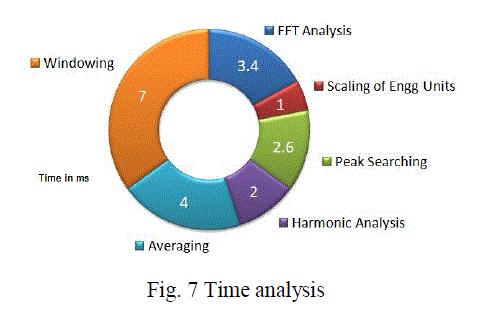 |
| Total processing time for 8-channel monitoring, fault analysis and opening/closing applications and cRIO standard operating system took approximately 200 ms. Four fault types were considered in this work; viz., stator winding fault, broken rotor bars, bearing (outer race) fault and static eccentricity fault. The combined faults of broken rotor bars and eccentricity exhibited precise results, as per the expectations. The other fault combinations also have performed better, but needed trial and error series of system tuning. subVIs, which were fed from Flux sensor demanded more efforts in the calibration of the sensor output. However, diagnostic logic and algorithm have proved their accuracy and robustness. |
CONCLUSIONS |
| In this paper, a cRIO based condition monitoring system for identification of faulty section of an Induction Motor has been described and presented. The existing various fault frequency analyses of Induction Motors are described. Effort is made on the optimized utilization of cRIO system in FPGA environment for fault identification and detection of Induction Motor. The paper demonstrates the development of software and hardware units, which are established in the reconfigurable cRIO environment. Broken rotor bar faults and three axes vibration effects have been tracked and monitored from the proposed method of identification. The estimated cost of the proposed system is comparatively less than that is priced in the commercial rate, but still the cost can be even reduced considerably for the multiple units of such systems. |
References |
|